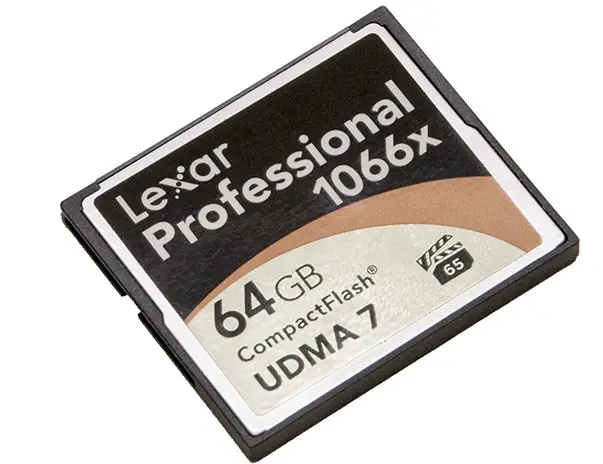
The external box the Lexar Professional 1066X CompactFlash card comes in is standard Lexar through and through. That is to say it is an all-black affair that loudly proclaims its professional credentials to the world. On the front you get a nice shot of the card itself, the model name, capacity, and type of card it is. The last is important as Lexar uses the same shipping container for multiple types of cards (CompactFlash, SD, etc). This can cause some minor confusion at the retail level, but is not overly worrisome as it would take effort to accidentally purchase the wrong model.

On the positive side the back of the case not only goes over the usual details but also states what the cards performance rating is in MB/s. More importantly t lists both the read and write performance specifications. In the 1066X case that is 155Mb/s write and 160MB/s read. Including these crucial details is not new to the 1066X line, but we are glad to see that Lexar continues to do so. For those interested 155/160 is much greater improvement over the 800x than the ‘1066X’ vs ‘800X’ ratings would lead you to believe. To be precise the 800X series is rated for 75MB/s and 120MB/s read – or less than that half the write performance and three quarters of the read performance of the 1066X series. Further stepping down a notch the 600X series was rated for a rather anemic 45MB/s write and 90MB/s read.

Obviously with the 1066X series Lexar has taken the harsh criticisms of the 800X series to heart and ensured that no one would ever complain about there being almost no difference between the new faster version and the ‘slower’ older version. Also in keeping with this recommitment to performance is the fact that the 1066X series has been guaranteed to meet the 65MB/s Video Performance Guarantee. The VPG-65 standard is rather difficult standard to meet but ensures that in a ‘worst case scenario’ the 1066X will deliver at least 65MB/s worth of sustainedperformance. Compare this to the 800X series which only meets to the VPG-20 standard (20MB/s). That is a massive improvement for generation.

Before purchasing any CompactFlash card we highly recommend looking for the VPG logo on the card itself. The VPG Logo is a “Clapper Board” with a number inside that specifies the minimum guaranteed write speed. If it is ’20’ it is VPG-20, if its 65 it is VPG-65, etc. etc. This certification is your guarantee of quality and performance….and is rarely found on lower end / no-name cards.

The accessories which accompany the Lexar Professional 1066X 64GB are fairly standard for Lexar Professional series- that is to say very good for this market. In grand total you get protective ‘travel’ case, and a free copy of Lexar’s Image Rescue 5 program. The latter of which retails for about $35 and as we will go over later in the review is well worth the asking price.

As expected the Lexar Professional 1066X 64GB is a Type 1 CompactFlash card and as such Lexar is highly restricted in what they could do on the form-factor side of the equation. In fact, except for the actual speed rating on the label there is no way to tell a Lexar 600X, from an 800X, from a 1066X card. All are Type 1 CF cards – 43mm x 36mm x 3.3mm – and are keyed so as to make inserting them upside down very….very difficult. It is not impossible to cram a Type 1 in the wrong way, but it would take a lot of effort. Needless to say if your shiny new Lexar 1066X CF card is not fitting, stop what you are doing and check that you are not trying to do exactly that!

The fact that it’s so darn difficult to tell one Lexar model from the next is a shame as while the form-factors are the same the NAND and controller housed inside does radically vary from model to model. We can’t fault Lexar for following the standard to the letter, but Lexar should have modified their color scheme from generation to generation. Instead, by using the exact same color scheme for numerous years, it can make it confusing to pick out a specific card if you have a camera bag full of cards.

To help alleviate this we recommend doing what we usually do: marking the clear protector case with a distinctive label. While a sharpie dose work in a pinch, if you have a labeler that would be better…and an exact-o knife is even better still. The last allows you to know by feel what card is what. To do this all you need do is put an ‘X’ for 1066x, 8 for 800x, etc. and you will be much better off.
For those who have never actually handled a CompactFlash card – and are still just at the research phase. CompactFlash cards actually do come in two distinctive standards. Type 1 and Type 2. Both have the same length and width, but Type 2 are 5.5mm thick instead of 3.3. This was done so as to allow Microdrive versions – literally a small hard drive stuffed inside the CF form-factor. Thankfully that idea died an early death and the chances of ever coming across a Type 2 card are slim. Type 1 cards are the default standard and most companies don’t even make Type 2 cards anymore. The only time you may come across one is if you purchase a CF to SD card adapter. We will not comment on why you would want to do that, but be warned that you had better make sure the Type the adapter is and if your camera supports Type 2 cards before purchase!











